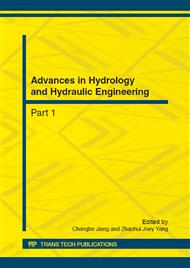p.609
p.615
p.619
p.628
p.634
p.643
p.647
p.653
p.658
Finding Best Locations for Rainwater Drainage Lines Using DTM, GIS, and Greedy Heuristic
Abstract:
In this paper, a new semi- automatic method for finding best locations for rain-water drainage lines is developed. The developed method is based on a heuristic greedy algorithm and relies on a digital terrain model (DTM) that can be generated from digitized contour lines or from new remote sensing technologies, such as the airborne laser scanning LiDAR (Light Detection and Ranging) systems. The developed algorithm in this paper uses heuristics and a neighborhood search to find the best locations for rain-water drainage lines between two defined points by minimizing the objective function value by considering a set of constraints, including constrained elevation values and downward slope. The developed algorithm is implemented in a computerized model named (CPline_Route) developed in Microsoft Windows Visual C++6 and was equipped with Graphical User Interface (GUI) to friendly enable users enter their desired parameters and specify an approximate initial line interactively. The performance of the developed computerized tool was tested by restricting a search around a contour line with constrained elevation values, and the result obtained demonstrated that the developed algorithm is effective. It noteworthy that optimal solution cannot be guarantee using greedy heuristic developed in this study. It can be concluded that the developed method is feasible for planning new rain-water drainage lines for new residential areas in developing countries where heavy rains are frequent, and potentially to be useful for planning new pipelines.
Info:
Periodical:
Pages:
634-640
Citation:
Online since:
October 2012
Authors:
Keywords:
Price:
Сopyright:
© 2012 Trans Tech Publications Ltd. All Rights Reserved
Share:
Citation:


